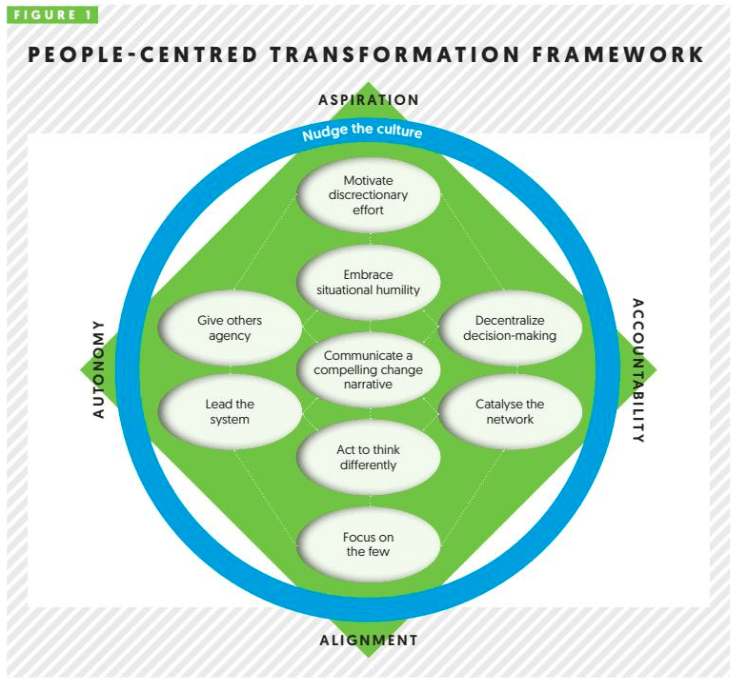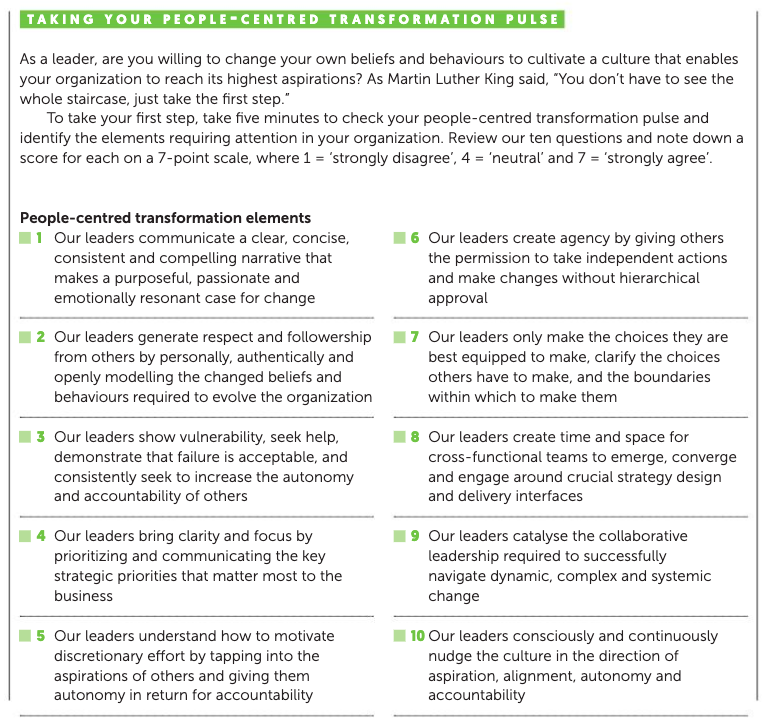People-centred transformation is an urgent priority for a fast-changing world
The existential threat facing organizations is clear. They must change, or they will die.
Organizations cannot change unless their people change, and most transformation efforts fail because organizations over-emphasize the tangible side of change and under-emphasize the emotional one.
- The deficient response: tangible transformation
- Putting people first
- Communicate a compelling change narrative
- Act to think differently
- Embrace situational humility
- Focus on the few
- Motivate discretionary effort
- Give others agency
- Decentralize decision-making
- Catalyse the network
- Lead the system
- Nudge the culture
- Activating the People Manifesto
By Prof. Dr. Tony O’ Driscoll, Research Fellow at Duke Corporate Education
Since the year 2000, just over half of the names of companies on the Fortune 500 list have disappeared. Forecasts paint an even grimmer picture: Innosight predicts that 75% of today’s S&P 500 companies will be replaced within ten years. Organizations are perishing at alarming rates because they can’t keep up with intensifying levels of change and complexity in the business ecosystem.
The existential threat facing organizations is clear. They must change, or they will die.
The deficient response: tangible transformation
Changing organizations is not easy. Robin Speculand reports that the failure rate for organization transformation over the last 15 years is as high as 60-90% (Excellence in Execution, 2017). Organizations cannot change unless their people change, and most transformation efforts fail because organizations over-emphasize the tangible side of change and under-emphasize the emotional one.
BCG reports that people in organizations that have a complicated structural, procedural and/or governance change imposed upon them are three times more likely to be disengaged than those who don’t. As Charlene Li has argued in her 2019 book The Disruption Mindset, organization change works when you identify the key beliefs and behaviours you want to change and then create new supporting structures, processes and governance mechanisms – not the other way around.
Putting people first
Brightline’s 2019 People Manifesto argues that people form the link between strategy design and delivery. People turn ideas into reality; they are the strategy in motion. They are the organization’s most important source of competitive advantage and yet, paradoxically, they are often also the organization’s most misunderstood and least leveraged asset.
As my latest research with Brightline emphasizes, successful organization transformation requires an empathic, people-centred approach to change that nurtures a culture of aspiration, alignment, autonomy and accountability. There are ten key elements of a people-centred transformation framework (see Figure 1).

Figure 1 - People-centred Transformation Framework
Communicate a compelling change narrative
In 1963, Dr Martin Luther King did not say, “I have a plan.” People need to believe that the achievement of a shared aspiration is possible and worthy of their effort before they are willing to change their behaviour to make it happen. Communicating a compelling narrative that makes a purposeful, passionate, and emotionally resonant case for change motivates people to let go of the past and reach for the future.
Act to think differently
Herminia Ibarra has shown that leaders who deliberately “act their way into a new way of thinking” are more successful in changing their own behaviour and motivating changed behaviour in others. Furthermore, the visible modelling of changed behaviour generates respect and followership from others: it is key for motivating others to change their own behaviour.
Embrace situational humility
Leaders must embrace what Amy Edmondson calls “situational humility”, by showing vulnerability, seeking help, asking questions and demonstrating that failure is acceptable. Humility helps to build the foundation of trust and psychological safety which gives others the confidence to engage in open, transparent and authentic interactions around change. This kind of trusted reciprocal interaction is critical: research has shown that failing to work together to make change happen is a significant barrier to successful long-term transformation.
Focus on the few
Upon his return to Apple in 1997, Steve Jobs eliminated more than 70% of Apple’s products and defined a simple two-by-two grid to bring clarity and refocus his company’s efforts. Job’s message was clear and simple: “Focus is about saying no.” While the benefits of collaboration are well documented, too much cross-functional teamwork can burn employees out and sap their productivity. To reduce collaborative overload, leaders must adopt a portfolio-based approach to change, ensuring that people’s energy and attention is squarely focused on the vital few change initiatives that matter most.
Motivate discretionary effort
Discretionary effort is what people choose to do above and beyond what is required of them by the organization. It is a significant source of potential energy for strategic change initiatives, but extrinsic motivational levers such as fear and poorly-designed reward and recognition policies dampen people’s motivation to activate their discretionary effort. Leaders must instead focus on the intrinsic motivational levers that compel people to go the extra mile. This means tapping into people’s aspirations and giving them autonomy in return for accountability.
Give others agency
Charlene Li has shown that organizations which give their people agency – “the permission to take independent action or make changes without approval” – are far more likely to succeed in transformation. By giving others agency, questions of who leads and who follows are no longer defined by hierarchical positions, but by the situation. Leadership becomes a give-and-take process of social influence to maximize the efforts of others.
Decentralize decision-making
Rob Cross’s Organizational Network Analysis (ONA) research shows that leaders who are unwilling to let go of decision-making slow their businesses down. A recent Harvard Business School study found that 54% of organizations recognized as transformation leaders have decentralized decision-making, compared to only 15% of transformation laggards. Roger Martin envisions organizations as “decision factories” and argues that leaders should only make the choices that they are best-equipped to make. They should clearly explain the rationale behind those choices, clarify the choices everyone else has to make, and define the boundaries in which to make them.
Catalyse the network
According to a 2017 study by the Economist Intelligence Unit (EIU), sponsored by Brightline, organizations that excel at changing their business purposefully orchestrate dynamic connections and interactions between those who design a change initiative and those who deliver it. John Kotter argues that organizations must create a “second operating system” devoted to the dynamic design and delivery of strategy, using an agile, network-like structure and a very different set of processes. To boot up this second operating system, leaders must make silos irrelevant, place a premium on organization agility, and nurture an ecosystem of self-organizing cross-functional teams.
Lead the system
Peter Senge argues that we need a new kind of leader – a systems leader – to successfully navigate dynamic, complex and systemic change. Research from Deloitte shows that organizations that focus on building systemic level leadership capabilities attain 37% higher revenue per employee, 9% higher gross profit margin, and are five times more likely to be highly effective at anticipating and responding to change.
Nudge the culture
Another recent EIU study identified “cultural attitudes” as the primary barriers to successful strategy implementation (Closing the Gap, 2017). Edgar Schein asserts that culture cannot be separated from strategy, because strategic thinking is deeply coloured by tacit cultural assumptions. Culture, therefore, acts as a limiting and resistive force to both the design and delivery of a strategic change initiative.
While culture itself is notoriously hard to change, it cannot be left to chance. The most successful transformation leaders recognize how to consciously and continuously nudge culture in the direction of aspiration, alignment, autonomy and accountability.
Activating the People Manifesto
The four tenets of Brightline’s People Manifesto are: that followership matters as much as leadership; collaborative efforts must be strategically focused; culture can’t be left to chance; and people must believe in the change. The ten elements outlined above are designed to activate these tenets.
Martin Luther King did not have a plan. He had a dream that changed the world. Putting people first, by activating a people-centred transformation approach, can make organizational dreams real.

This article was originally published at Dialogue Review
This research was supported by the Brightline Initiative and carried out by Dr. Tony O’ Driscoll at Duke Corporate Education.